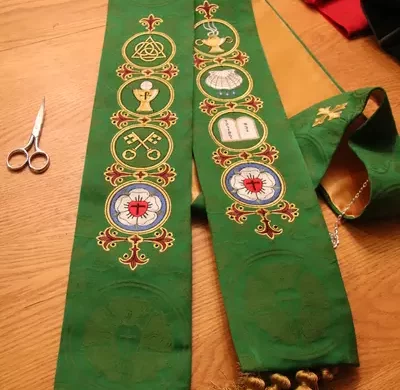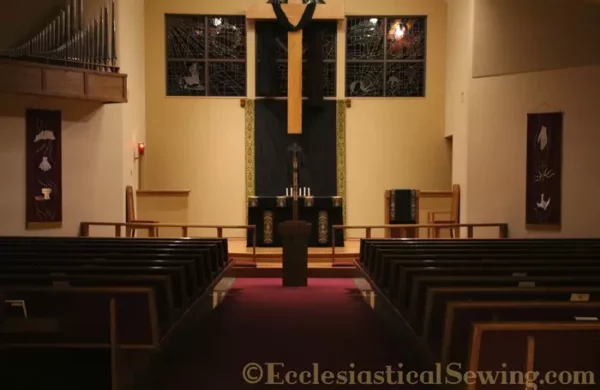
O Sapientia – O Wisdom: The Great O’ Antiphon for December 17
O Wisdom, coming forth from the mouth of the Highest, reaching from one end to the other, mightily and sweetly ordering all things: Come and teach us the way of prudence.
The Liturgical Calendar defines the Church year, outlining a series of seasons and festive occasions that liturgical ceremonies observe throughout the year. Christians used this calendar as a guide, so they could properly celebrate the significant events in the life of Christ and the Church.
The liturgical year is divided into six seasons, each with its own theme and focus. Advent, which heralds the coming of Christ, begins the Church year, followed by Christmas, which celebrates the birth of Jesus. Lent is a time of penance and reflection, leading up to Holy Week, which culminates in the celebration of Easter, the most important feast of the Christian calendar. Ordinary Time follows Easter, with a focus on the teachings of Jesus Christ and the Church. The season of Advent then begins again, marking the end of one liturgical year and the beginning of another.
Throughout the year, the Liturgical Calendar also includes several important feasts and solemnities, such as the Feast of the Epiphany, the Transfiguration, the Assumption of the Blessed Virgin Mary, and All Saints’ Day. These celebrations allow the faithful to honor the lives of the saints and reflect on the significance of their contributions to the Church.
By following the Liturgical Calendar, Christians can participate in a rich tradition of liturgical worship that connects them to the history of the Church and the life of Christ. It provides a framework for the celebration of the mysteries of faith and ensures that Christian followers would never lose sight of the significance of these events in their lives.

O Wisdom, coming forth from the mouth of the Highest, reaching from one end to the other, mightily and sweetly ordering all things: Come and teach us the way of prudence.

St. Margaret is a bold rich blue that has a stunning depth of color. It is vibrant and full of life. St. Margaret is one of the few Liturgical Brocade fabrics available in blue. The fabric is pinned to the embroidery frame to stitch a long pastor stole embroidery.

Gaudete is a special Sunday in Advent when the readings have a lighter tone in the middle of what is a Penitential Season. This is the third Sunday in Advent when a rose or pink candle is lit on the Advent wreath. The color change reminds us that Christmas is near. We only need to wait a bit longer and our Alleluia will resound once again. Lent is also a Penitential Season of the church year. Laetare is on the fourth Sunday in Lent

Reformation 2018 – 501 Years in the Making:: an incredible anniversary. The Reformation Embroidery Designs were created by Edward Riojas and Carrie Roberts. This set was the first major collaborative design collection created by both artisans and it marked the beginning of what has become a wonderful working relationship and friendship. The designs are unique in the world of vestment making.

Alleluia! Christ is Risen. He is Risen indeed! Alleluia!
May the joy of our Risen Saviour live in your hearts now and forever more. Blessings and peace to all of the Ecclesiastical Sewing Family and Friends.

Good Friday Art: Private Collection by Carrie Roberts.

The Lenten Season is a time of year when black vestment fabrics are worn. The use of black will depend on which rites a church follows, but it is not uncommon to use black for Ash Wednesday as well as for Good Friday. This black brocade with a circle and cross motif has a nice weight and hand. It would work great if black hangings such as plain black banners were needed to drape in a church to create a somber mood for Good Friday. The fabric could also be used for any variety of church vestments and hangings.
Gaudete Sunday is the third Sunday in Advent and is a reprieve in this season–which by nature is a penitential season. Gaudete Sunday gives us a glimpse of the joy that awaits us and lightens the mood–one way this is done is with the change of the vestments from violet or blue to a rose color. Gaudete is the plural present active imperative of the Latin verb “to rejoice.”
Today we give thanks for the life of Saint Damasus I. He was Bishop of Rome from 366 A.D. to 384 A.D. During this period, Christianity was declared the official religion, Latin became the official language of the Church (as opposed to Greek), & Saint Damasus encouraged Jerome to translate the Bible into Latin.

In Honor of the 500th Anniversary of the Reformation

October 8th, is clergy appreciation day in the USA. Ecclesiastical Sewing is, of course, your number one source for designing something spectacular for your pastor, priest, bishop, or other clergy members.

The Great Antiphons of Advent or The O Antiphons of Advent. An antiphon’s purpose is to summarize the main point of the psalm which helps make the connection between the psalm and the service on which it is chanted or sung. These Great Antiphons point the way toward Christmas and Christ. They talk about the Old and New Testaments and summarize the ties that bind everything together. They are a final push and lead us directly to our Lord’s birth, but more importantly, they shed light on the rest of the story and the greater picture.

We enter a season filled with green trees and grass dotted with bright pink, purple, red, and white the flowers blooming profusely all around us. One glance around nature provides a feast of green shades for the eye to behold. It brings the entire world to life. Green is also the color for ordinary times in the church years. With the long Trinity Season or the “Green” Season just getting underway in the church year.

The Ecclesiastical Sewing Family’s Easter in 2017 and a special church project. Dossal curtain – Dossals, traditionally adorned with intricate embroideries, like the Lanercost Dossal. Tailored to fit sanctuary dimensions, for instance, is 88” wide and 124” long, complementing stained glass. A captivating coincidence forms a cross with the dossal and stained glass, as seen in the Good Friday dossal, the dossal and the stained glass make a cross on the back wall behind the big wooden cross.

Good Friday in 2017 – church adhered to solemn customs, draping the altar in black with six candles, the seventh being the Paschal candle. While black is our choice, I found practices in other churches, employing red or violet. Despite the somber tone of Good Friday services, they set the stage for a joyous Easter celebration.
You must be logged in to post a comment.